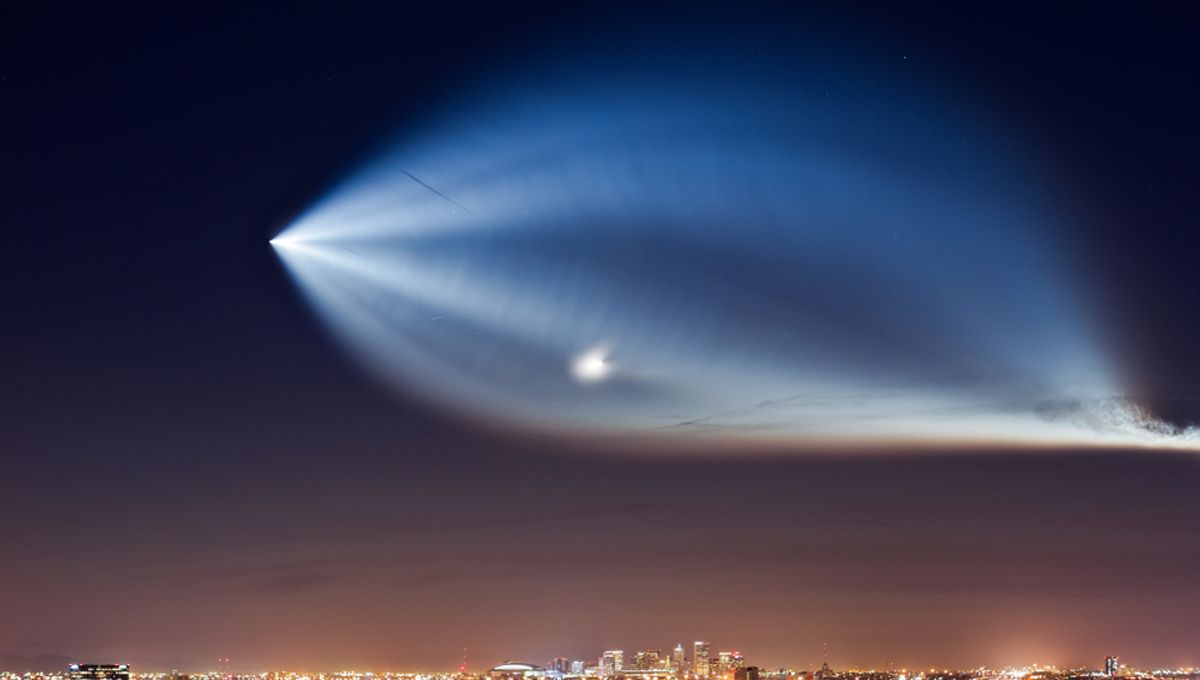
Last week, many Californians witnessed a red glow in the sky that could have been mistaken for an aurora. The recent burst of solar activity is bringing polar lights to lower latitudes than has happened for a long time, but nothing this large and bright has reached the outskirts of LA – instead, the sky colors came from a SpaceX rocket creating a hole in the ionosphere.
In the early days of space exploration, references were made to rockets “punching holes in the sky” and letting something awful through. Whether anyone really feared this, or it was just a way of mocking technophobes is lost in the mists of time, but it turns out something of the sort really can happen.
A 2018 paper in Space Weather (a peer-reviewed journal, not the helpful website) explores the impact of a SpaceX Falcon 9 flight the previous year to launch Taiwan’s FORMOSAT-5 satellite. It reports the rocket “Induced gigantic circular shock acoustic waves (SAWs) in total electron content (TEC) over the western United States […] The rocket-exhaust plume subsequently created a large-scale ionospheric plasma hole (~900 km [559 miles] in diameter).”
Some would call this a thinning, not a hole, but over an area more than 500 miles wide, TECs were reduced by up to 70 percent compared to normal conditions. Not all the hole was equally affected, with just 10 percent TEC loss in some areas.
That event didn’t attract much public attention, but a similar launch on July 19 this year did after photographs were posted on social media, including Musk’s own website, whatever he is calling it.
Rockets release a lot of gasses in their exhaust plumes. Chemical recombination in their wake can affect the charged particles, particularly electrons, that form the Earth’s ionosphere, the ionized upper part of the Earth’s atmosphere
For most Californians, this was probably just a chance to see the sky glow without having to visit Canada. However, just as the pleasure of watching a Starlink skytrain fades once satellites are so numerous they obscure one’s view of the real stars, this may not look so nice when it happens more often.
Besides the view, the most immediate potential consequence of disrupting the ionosphere is the potential to disrupt radio transmissions, which are normally bounced off the ionosphere. The 2017 launch is calculated to have possibly created an additional error of around 1 meter (3 feet) in the precision of GPS.
The 2018 paper makes clear that most Falcon 9 launches have much smaller effects. “This is the largest rocket-induced circular SAWs on record, […] and was due to the unique, nearly vertical attitude of the rocket during orbit insertion,” the authors note. However, future generations of rockets, with the capacity for larger payloads, could produce events like this even when launching on more traditional paths, making large ionosphere holes common without regulation. Similarly, a one-meter GPS error may not be much of a worry, but if multiple factors combine to cause more intense TECs disruptions this may be an early warning sign.
Source Link: Auroral-Like Glow Produced By SpaceX Rockets Making Holes In The Ionosphere